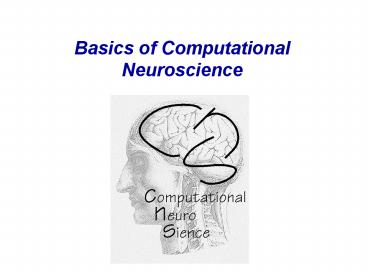Basics of Computational Neuroscience - PowerPoint PPT Presentation
1 / 26
Title:
Basics of Computational Neuroscience
Description:
Basics of Computational Neuroscience Lecture: Computational Neuroscience, Contents Neuroscience: Psychophysics (human behavioral studies): Neurophysiology ... – PowerPoint PPT presentation
Number of Views:189
Avg rating:3.0/5.0
Title: Basics of Computational Neuroscience
1
Basics of ComputationalNeuroscience
2
The Interdisciplinary Nature of Computational
Neuroscience
What is computational neuroscience ?
3
Lecture Computational Neuroscience, Contents
1. Computational neuroscience and the perspective
of scientists versus that of behaving agents 2.
Levels of Information processing in the brain 3.
Neuron and Synapse Biophysical properties,
membrane- and action-potential 4. Calculating
with Neurons I adding, subtracting, multiplying,
dividing 5. Calculating with Neurons II
Integration, differentiation 6. Calculating with
Neurons III networks, vector-/matrix- calculus,
associative memory 7. Information processing in
the cortex I Correlation analysis of neuronal
connections 8. Information processing in the
cortex II Neurons as filters 9. Information
processing in the cortex III Coding of behavior
by poputation responses 10. Information
processing in the cortex IV Neuronal maps 11.
Learning and plasticity I Physiological
mechanisms and formal learning rules 12.
Learning and plasticity II Developmental models
of neuronal maps 13. Learning and plasticity
III Sequence learning, conditioning 14. Memory
Models of the Hippocampus
4
The Interdisciplinary Nature of Computational
Neuroscience
What is computational neuroscience ?
5
(No Transcript)
6
Neuroscience
Different Approaches towards Brain and Behavior
Behavior Reaction
Environment Stimulus
7
Psychophysics (human behavioral studies)
Environment Stimulus
Behavior Reaction
8
Neurophysiology
Behavior Reaction
Environment Stimulus
9
Theoretical/Computational Neuroscience
Behavior Reaction
Environment Stimulus
10
Levels of information processing in the nervous
system
11
CNS (Central Nervous System)
CNS
Systems
Areas
Local Nets
Neurons
Synapses
Molekules
12
Cortex
CNS
Systems
Areas
Local Nets
Neurons
Synapses
Molekules
13
Where are things happening in the brain.
Is the information represented locally ?
14
Untersuchungen von Patienten
Sehen ! Erkennen
CNS
Systems
Areas
Local Nets
Neurons
Synapses
Molekules
15
Results from human surgery
CNS
Systems
Areas
Local Nets
Neurons
Synapses
Molekules
16
Results from imaging techniques
CNS
Systems
Areas
Local Nets
Neurons
Synapses
Molekules
17
Functional and anatomical subdivisions of the
Cortex
Premotor cortex
Higher sensorial areas
Prefrontal association cortex
Parietal-temporal- occipital assoc. cortex
limbic association cortex
primary sensor and motor areas
18
Visual System
More than 40 areas ! Parallel processing of
pixels and image parts Hierarchical Analysis
of increasingly complex information Many lateral
and feedback connections
CNS
Systems
Areas
Local Nets
Neurons
Synapses
Molekules
19
Primary visual Cortex
CNS
Systems
Areas
Local Nets
Neurons
Synapses
Molekules
20
Retinotopic Maps in V1
V1 contains a retinotopic map of the visual
Field. Adjacent Neurons represent adjacent
regions in the retina. That particular small
retinal region from which a single neuron
receives its input is called the receptive field
of this neuron.
V1 receives information from both eyes.
Alternating regions in V1 (Ocular Dominanz
Columns) receive (predominantely) Input from
either the left or the right eye.
Each location in the cortex represents a
different part of the visual scene through the
activity of many neurons. Different neurons
encode different aspects of the image. For
example, orientation of edges, color, motion
speed and direction, etc. V1 dicomposes an image
into these components.
21
Orientation selectivity in V1
Orientation selective neurons in V1 change their
activity (i.e., their frequency for generating
action potentials) depending on the orientation
of a light bar projected onto the receptive
Field. These Neurons, thus, represent the
orientation of lines oder edges in the image.
stimulus
22
Superpositioning of maps in V1
Thus, neurons in V1 are orientation selective.
They are, however, also selective for retinal
position and ocular dominance as well as for
color and motion. These are called features.
The neurons are therefore akin to
feature-detectors.
For each of these parameter there exists a
topographic map.
These maps co-exist and are superimposed onto
each other. In this way at every location in the
cortex one finds a neuron which encodes a certain
feature. This principle is called full
coverage.
23
Local Circuits in V1
stimulus
Selectivity is generated by specific connections
24
Layers in the Cortex
CNS
Systems
Areas
Local Nets
Neurons
Synapses
Molekules
25
Local Circuits in V1
LGN inputs
Cell types
Local connections
To different cortex areas
To subcortical areas
Coll. Sup., Pulvinar, Pons
LGN, Claustrum
Spiny stellate cell
Smooth stellate cell
26
Structure of a Neuron
At the dendrite the incoming signals arrive
(incoming currents)
At the soma current are finally integrated.
At the axon hillock action potential are
generated if the potential crosses the membrane
threshold
The axon transmits (transports) the action
potential to distant sites
At the synapses are the outgoing signals
transmitted onto the dendrites of the
target neurons































